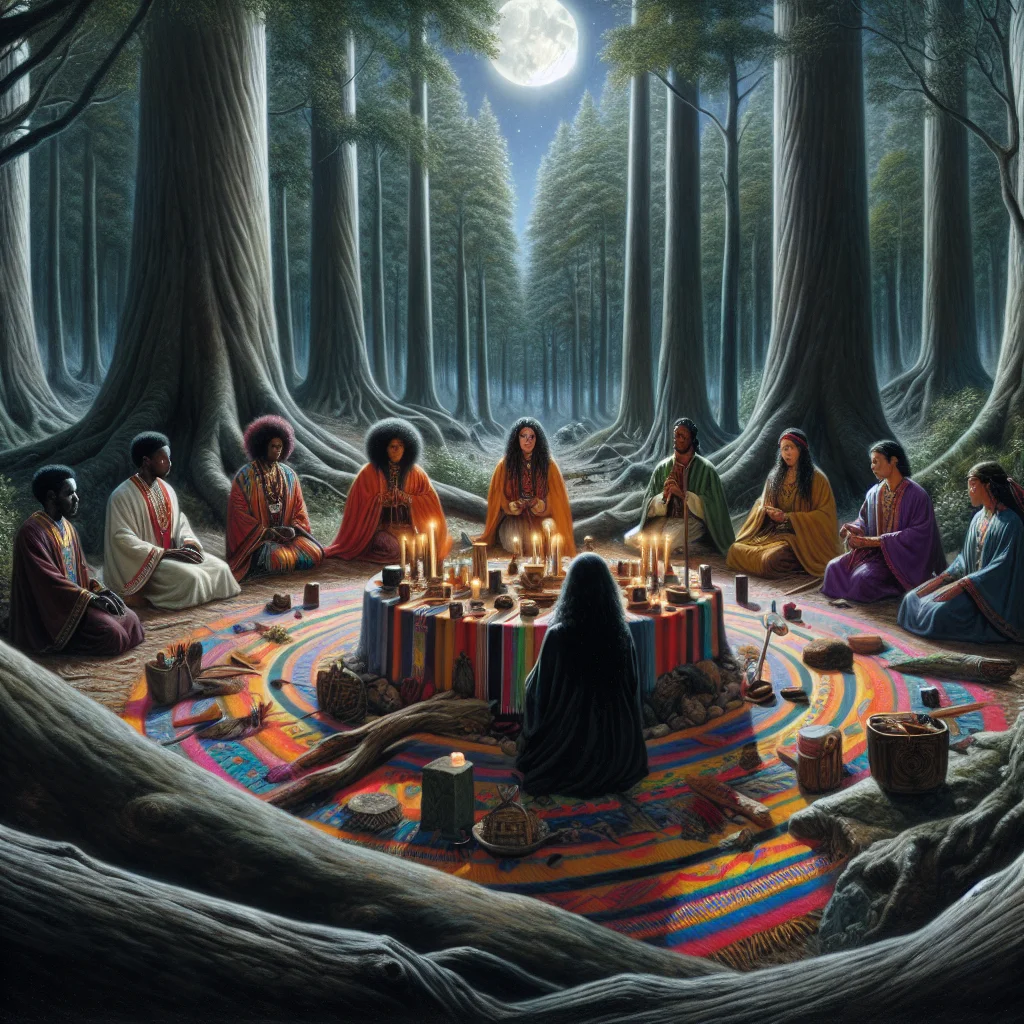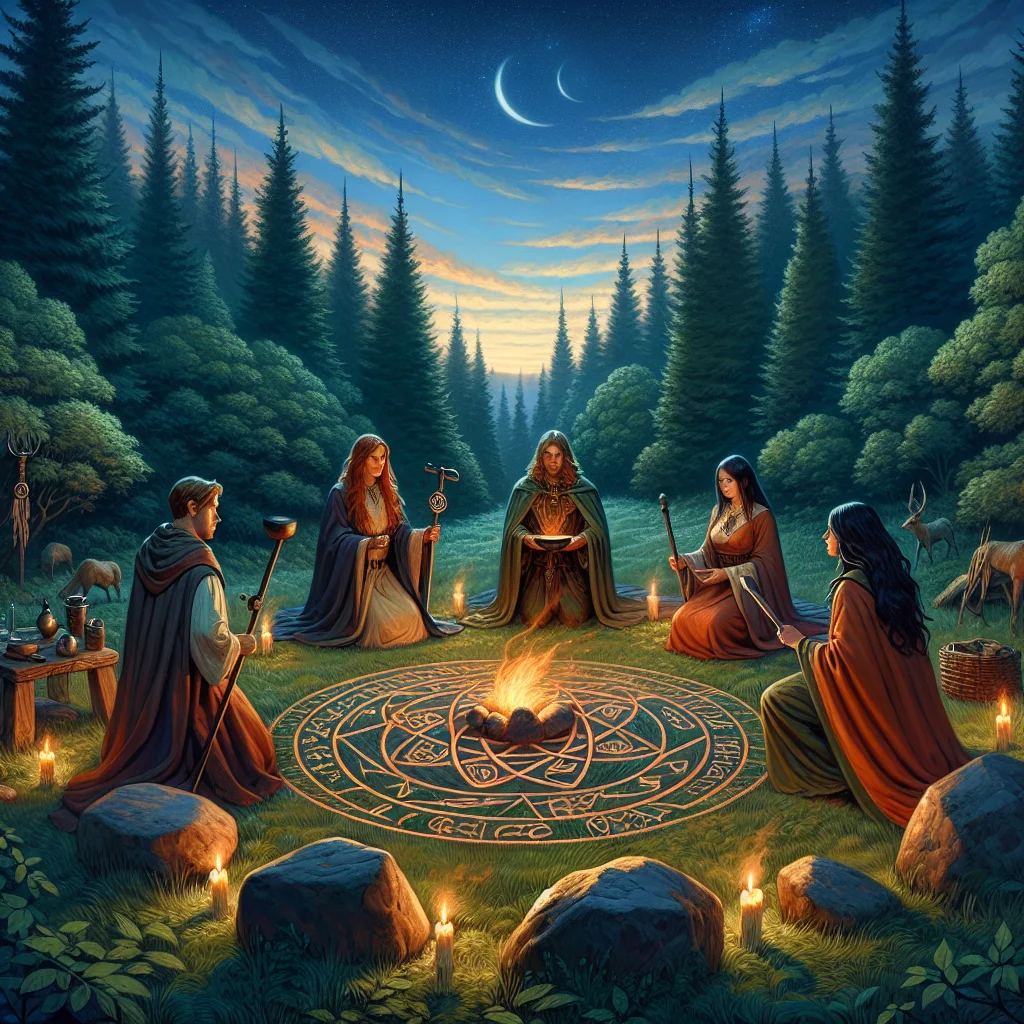As an Amazon Associate I earn from qualifying purchases.
↻
Last updated: December 24, 2025

Wicca, a contemporary pagan and witchcraft religion, surprises many by having roots dating back to pre-Christian and indigenous beliefs. This earth-centric spirituality is known for making emphasis on the divine feminine, the importance of nature, individual choice, and ethically aligned magical practices. One of the key elements of the Wiccan way are the ceremonies, a series of crafted rituals imbued with deep meaning.
The origin and crafting of Wiccan ceremonies can be traced back to the foundation of Wicca in the 20th century. Its mere existence is a testament to adaptability and fluidity, merging old-world, pagan rites with a modern sensibility. It was during the 1950s, when Wicca started to sweep the U.K. and later on the U.S, that the ceremonies, as we know them today, started to take form. They are an inclusive set of rituals, which facilitate a personal connection with the divinity found in nature and in ourselves.
A Wiccan ceremony typically centers around the cycles of the moon and the sun, the changing seasons, and the mysteries of life and death. Notably, these rituals are crafted with a deep meaning and understanding of nature’s rhythm. They are primarily an attempt to harmonize with the natural energies of the earth and universe. This concept of rhythm is central to the practice, where Wiccans often highlight eight significant points throughout the year: the Solstices, Equinoxes, and four other cross-quarter days. These are also paired with thirteen Esbats, or full-moon rituals, completing a lunar-solar ceremonial calendar.
Crafting a meaningful Wiccan ceremony lies in the balancing between structure, personal significance, and appropriate symbols. A Wiccan ceremony often begins with the casting of a circle, to create a sacred and pure space, followed by invoking the elements of earth, air, fire, and water. However, the specific content within the basic framework can be tailored according to the practitioner’s personal spiritual journey and needs. For some this may include psychic work, divination, healing circles or simply a moment of gratitude and connection with the divine.
The fascination with Wicca is continuously growing, particularly among millennials. According to a 2014 report by Pew Research Centre, about 734,000 Americans identified as Wiccan. The captivating blend of ancient wisdom, individual freedom, and profound reverence for nature is at the heart of its appeal. Not only do these crafted rituals provide a meaningful sense of connectedness to the earth, but they also empower individuals to be the true agents of their own spiritual journeys. The allure of Wiccan ceremonies resonates largely because they suggest a different way of seeing, feeling, and navigating the world that echoes with authenticity and freedom.
Studies show that practicing mindfulness has myriad personal benefits, and it has found a unique platform in the world of Wicca. Crafting and conducting a thoughtful and deliberate Wiccan ceremony promotes deep personal reflection and cultivation of a self-nurturing perspective. The central themes of connectedness, respect and reverence to nature, individual freedom, and equality in spiritual practices are just as relevant today as they have ever been. Hence, the crafting of these rituals certainly represents a fulfilling and rewarding process for the holistic well-being of Wiccans. Today, more than ever, conducting these age-old rituals gives Wiccans a sense of solace, empowerment, and familiarity during uncertain times.
What is the Deep Meaning Behind Wiccan Rituals and Ceremonies?
Embarking on a journey towards Wiccan rituals and ceremonies is to delve into a rich world of earth-based spirituality, deeply rooted in nature and the elements. These ceremonies hold profound meaning, crafted meticulously to honor the divine and to create a sense of unity and balance. To understand Wiccan rituals is to appreciate the essence of duality, seasonal cycles, and a deep-rooted connection to the earth. Weaving this understanding into the fabric of one's daily life brings about numerous advantages, such as increased mindfulness, enhanced spiritual awareness, and a sense of inner peace. In the following section, we will explore these aspects in greater detail, uncovering the beauty, intricacy, and profound meaning of Wiccan ceremonies.
Wiccan Ceremonies: An Emphasis on Self-Expression and Creativity
Wiccan ceremonies embody an inviting atmosphere of open-endedness and expansive creativity that allows the practitioners to craft rituals teeming with deep, personal meaning. Being a spiritual path deeply intertwined with nature, Wiccan rituals are crafted in synchrony with the lunar cycles and seasons, which in turn are representations of different energies and elements. The focus is to establish a connection to higher powers and the inherent wisdom of the natural world and the universe.
The Basic Structure of Wiccan Ceremonies
The fundamental structure of Wiccan ceremonies often follows a particular order – purifying the sacred space, casting a circle, calling the quarters or elements, invoking the deity or deities, stating the purpose, raising power, directing the energy, grounding, thanking the deity/deities and elements, and finally, opening the circle. While certain elements of the ritual are consistent, the specifics involved vary based on the individual or group's unique beliefs and traditions.
Casting The Circle
Casting the circle provides a boundary for the energy produced during Wiccan ceremonies and serves to protect those within. While doing this, the caster notes the four cardinal directions, acknowledging the elemental correspondences of east (air), south (fire), west (water), and north (earth).
Invoking the Deities
The divine is deeply revered in Wiccan ceremonies. Practitioners draw on the energies of the God and Goddess, or multiple deities if they follow paths like Dianic Wicca.
The Purpose
Each Wiccan ceremony carries a distinct purpose. It could be an Esbat (full moon ritual), a Sabbat (seasonal festival), or rites of passage like initiations, handfastings, or crossings. The aim is central to the ritual and directs how the ceremony unfolds.
Creating the Ritual
Personifying the Wiccan principle ‘If it harms none, do what you will,' Wiccan rituals are crafted to reflect personal meaning. Chants, invocations, spells, or symbolic actions can be designed intuitively, based on individual resonance, familial or traditional currents.
Key Components of Ritual Crafting
Symbols and Tools: Many Wiccan rituals include the use of symbolic tools such as athame, wand, chalice, and pentacle. These toolset represents the elements and different aspects of the divine. However, these are not mandatory, and alternatives can be used.
Correspondences: To create rituals with deep meaning, correspondences can be employed, such as colors, herbs, crystals, tarot cards, deities, and even time of day or phase of the moon.
Ultimately, creative self-expression is encouraged in crafting Wiccan ceremonies, nurturing a deep sense of empowerment and spiritual connection. There's a saying in Wicca, “we are not Wiccan because we share the same beliefs; we are Wiccan because we share the same questions.” Each ritual is a journey in answering these questions, crafting a uniquely personal spiritual path.
Emphasizing the growth of Wiccan practices, a report by the Pew Research Center revealed that the number of self-identified Wiccans in the United States had grown from an estimated 8,000 in 1990 to 342,000 in 2008, indicating a significant acceptance and practice of these impactful rituals.
1.
What is the purpose of Wiccan ceremonies?
Wiccan ceremonies, or rituals, serve several purposes. They can be a way to honor deities, celebrate the seasons, mark life transitions, make magic, or simply create a spiritual bond with nature. Every Wiccan ceremony is deeply personal and has meaningful components specific to the individual or group performing it.
2.
Can anyone participate in Wiccan ceremonies?
Generally, anyone with a genuine interest and respect for the Wiccan tradition can participate in the ceremonies. However, some covens or private Wiccan groups may keep their ceremonies exclusive to their own members. It's always important to ask before participating.
3.
What can I expect to see during a Wiccan ceremony?
Wiccan ceremonies vary widely but often incorporate similar elements, such as the creation of a sacred circle, invocation of the elements and deities, symbolic gestures, rituals specific to the ceremony's purpose, singing, dancing, meditation, and communal feasts.
4.
Are Wiccan ceremonies always held outdoors?
While many Wiccan rituals are conducted outdoors to connect better with nature, ceremonies can also be held indoors, especially during inclement weather or if participants have privacy concerns. The most important factor is creating a suitable sacred space, wherever it is.
5.
What should I wear to a Wiccan ceremony?
What to wear depends on the preference of the individual or group performing the ceremony. While some prefer ritual robes, others may choose everyday clothes or even choose to perform rites skyclad (naked). If you are joining a group, it is best to seek guidance from the group's leader.
6.
What tools are used in Wiccan ceremonies?
Typically, Wiccan rituals use tools that symbolize the elements of earth, air, fire, and water, plus a fifth representing spirit. These may include a pentacle (Earth), athame or sword (Air), wand (Fire), chalice (Water), and cord or crystal (Spirit). How these tools are used varies by tradition.
7.
What is the significance of a circle in Wiccan ceremonies?
In Wiccan rituals, a circle represents a sacred, protected space where magic can be safely practiced. It also symbolizes unity, infinity, and the cyclical nature of life and the seasons. The act of casting a circle sets apart the ritual area from the mundane world.
8.
Do all Wiccan ceremonies involve magic?
Not all Wiccan ceremonies involve magic in the sense of spellwork. The focus of a ceremony can range from celebrating a seasonal festival, honouring deities, meditating, or personal spiritual development. When magic is practiced, it is often seen as a natural means of creating change.
9.
Are animal sacrifices a part of Wiccan ceremonies?
No, animal sacrifices are not a part of Wiccan belief or practice. Wicca holds a deep respect for all life and promotes harm to no one, including animals. This principle is often summed up in the Wiccan Rede with the phrase “An it harm none, do what ye will”.
10.
How can I create my own Wiccan ceremony?
Creating your own Wiccan ceremony involves personal study and understanding of Wiccan traditions, along with introspection and creativity. Start by deciding the purpose of the ceremony, then choose elements, symbols, and actions that feel meaningful to you. Remember, your sincerity is what truly matters in a ceremony.

In Conclusion
Throughout the discussion on Wiccan ceremonies, it has been proven that rituals are an integral part of Wicca, serving to create a sacred space, connect practitioners to the divine, and facilitate personal growth and transformation. Crafting rituals with deep meaning requires an understanding of the core principles of Wicca, an appreciation of the natural cycles and elements, and the incorporation of personal symbols and intentions. The importance of preparation, cleansing, and grounding was emphasized, as well as the use of tools like athames, chalices, and pentacles.
Moreover, rituals often begin with the casting of a Circle and invoking of the watchtowers, followed by the worshipping of the Goddess and God, and culminates in the sharing of Cakes and Ale. Sabbats and Esbats are key recurring Wiccan ceremonies that honor the wheel of the year and lunar cycles respectively. The MGoddess and God play vital roles in these ceremonies, embodying aspects of nature and life's cycles. Recognizing the profound significance and potential of ritual in Wicca can further embed one's practice within a larger, cosmic context, lending a deep sense of connection and meaning to everyday, mundane reality.
Amazon and the Amazon logo are trademarks of Amazon.com, Inc, or its affiliates.
Continue Your Magical Journey
Free Witchcraft Starter Kit
Get 6 free printable PDFs: grimoire pages, moon calendar, spells, crystals, herbs, and tarot journal.
We respect your privacy. Unsubscribe anytime.
Enhance Your Practice
As an Amazon Associate, I earn from qualifying purchases.

